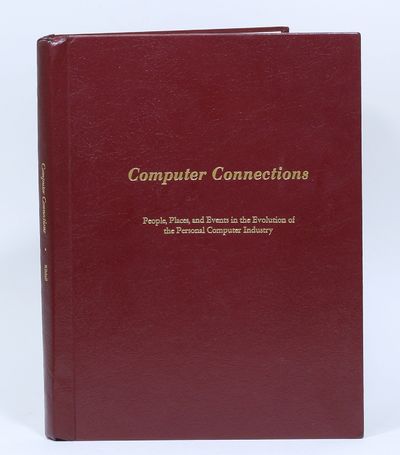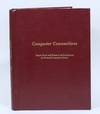signed first edition
1993 · Austin, Texas
by KILDALL, GARY
Austin, Texas: Gary Kildall, 1993. Special First Edition. ONE OF FIFTY COPIES OF GARY KILDALL’S COMPLETE MEMOIR: UNTOLD REFLECTIONS ON COMPUTER REVOLUTION AND PIONEERS LIKE JOBS, GATES, AND WOZNIACK. INSCRIBED BY KILDALL. Today, Gary Kildall is often known as the man who might have been Bill Gates. Computer-science legend has it that when IBM came to visit Kildall, hoping to utilize his operating system for their computers, “Gary was out flying.” The next day, IBM went to Bill Gates and Microsoft, and the rest is history [Tluong].
This rumor is false—it was Kildall and IBM’s inability to agree on a pricing model, not his absence, which caused IBM to go to Microsoft. Still, this story identifies two things about Kildall.
Firstly, Kildall’s genius in computer science design was to rival, if not surpass, Bill Gates.’ It is no accident that IBM hoped to acquire Kildall’s operating system before Microsoft’s. In 1974, Kildall created his own CP/M (Control Program for Microcomputers), the first standardized operating system that let users load and manage programs on floppy disks and run the same software across diverse hardware systems. He also pioneered PL/M, the first high‑level language compiled specifically for microprocessor‑based systems—used by Intel for decades [Tluong].
Secondly, though Kildall is often associated with a failure to close with IBM, he is also identified as an individual driven by values over profit. Kildall’s business acumen (or lack thereof), was motivated by his belief that computers must serve as learning tools before profit centers. This meant that Kildall was often unwilling to accept the aggressive pricing models utilized by rivals as reflective of his belief that the personal‑computer revolution must include everyone, regardless of class or position [Kildall].
Such a view is demonstrated in Kildall’s recount of Intel’s pricing models, as presented in his memoir:
“Says Jim, ‘Ok, so we sell the Intellec 8/80 for, say, $8,000 and then we sell them a fast paper‑tape reader for another $2,000. That makes $10,000 off the top. Ok, then we wait until we’ve sold a bunch of these paper‑tape systems and then introduce the floppy‑disk drive at $2,500 and ISIS software at another $1,000.’
I was dumbfounded. This was a direct attempt to block advancements in our society’s technology for the profit of Intel. It was a good lesson for me. I protested. I wasn’t listened to or even considered. But Jim Lally is now a very successful venture capitalist. I think this is a statement about how certain people manage to get others’ assets” [Kildall].
Kildall died in 1994 at the age of 52. The following year, the Software and Information Industry Association honored him with a posthumous lifetime‑achievement award, recognizing eight areas in which he contributed to the development of microcomputers. Kildall’s legacy remains one of technological genius, and principled pursuit of scientific progress [Tluong].
Though he never published an autobiography, in 1993 Kildall shared a draft of his memoir, Computer Connections, with close family and friends. It recounted his early industry work, his personal relationships to and judgments of individuals like Paul Allen, Steve Jobs, and Bill Gates, and even his own re-telling of the famous “flying story” [Kildall].
In Computer Connections, Killdall writes about a dinner with Bill Gates:
“Bill came to me in Pacific Grove one day in 1977 to discuss his current quandary about relocation of his Microsoft company. We invited him to stay that night at our home. Dorothy fixed a nice roast chicken dinner, and we had light conversation. Bill told us about the tickets he had received driving at high speed in his Porsche 911 through the main street of Albuquerque. We found a common topic since I, to my misfortune, also enjoy speed of the automotive type that sometimes, but not often, results in an encounter with The Law.”
While an excerpted version of the memoir appeared in 2016, only a handful of full manuscripts survive—distributed under strict ‘no reproduction’ orders. This copy is one of 50 originals, given to close family and friends: an essential document for understanding the true textures and relationships enabling the computer science revolution. Original copies contain the preface and concluding chapters, which publicly available versions of the memoir do not. This book is edition 24 out of the first 50.
Inscribed by Kildall in ink on the Preface Page: “To Lisa and Jackie, Merry Christmas. Gary” and signed again ("Gary") after the limitation statement.
Austin, TX: Gary Kildall, 1993, 1994. Small folio, original burgundy leatherette with gilt stamping. Fine condition.
EXCEEDINGLY RARE: We know of no other copy that has been on the market.
References:
- Kildall, Gary. Computer Connections: People, Paces, and Events in the Evolution of the Personal Computer Industry, 1993. https://d1yx3ys82bpsa0.cloudfront.net/kildall-p.1-78-publishable-lowres.pdf.
- Tluong. “Gary Kildall and the 40th Anniversary of the Birth of the PC Operating System.” CHM, August 30, 2019. https://computerhistory.org/blog/gary-kildall-40th-anniversary-of-the-birth-of-the-pc-operating-system/.
- “Who Made America? | Innovators | Gary Kildall,” n.d. https://www.pbs.org/wgbh/theymadeamerica/whomade/kildall_hi.html. (Inventory #: 2968)
This rumor is false—it was Kildall and IBM’s inability to agree on a pricing model, not his absence, which caused IBM to go to Microsoft. Still, this story identifies two things about Kildall.
Firstly, Kildall’s genius in computer science design was to rival, if not surpass, Bill Gates.’ It is no accident that IBM hoped to acquire Kildall’s operating system before Microsoft’s. In 1974, Kildall created his own CP/M (Control Program for Microcomputers), the first standardized operating system that let users load and manage programs on floppy disks and run the same software across diverse hardware systems. He also pioneered PL/M, the first high‑level language compiled specifically for microprocessor‑based systems—used by Intel for decades [Tluong].
Secondly, though Kildall is often associated with a failure to close with IBM, he is also identified as an individual driven by values over profit. Kildall’s business acumen (or lack thereof), was motivated by his belief that computers must serve as learning tools before profit centers. This meant that Kildall was often unwilling to accept the aggressive pricing models utilized by rivals as reflective of his belief that the personal‑computer revolution must include everyone, regardless of class or position [Kildall].
Such a view is demonstrated in Kildall’s recount of Intel’s pricing models, as presented in his memoir:
“Says Jim, ‘Ok, so we sell the Intellec 8/80 for, say, $8,000 and then we sell them a fast paper‑tape reader for another $2,000. That makes $10,000 off the top. Ok, then we wait until we’ve sold a bunch of these paper‑tape systems and then introduce the floppy‑disk drive at $2,500 and ISIS software at another $1,000.’
I was dumbfounded. This was a direct attempt to block advancements in our society’s technology for the profit of Intel. It was a good lesson for me. I protested. I wasn’t listened to or even considered. But Jim Lally is now a very successful venture capitalist. I think this is a statement about how certain people manage to get others’ assets” [Kildall].
Kildall died in 1994 at the age of 52. The following year, the Software and Information Industry Association honored him with a posthumous lifetime‑achievement award, recognizing eight areas in which he contributed to the development of microcomputers. Kildall’s legacy remains one of technological genius, and principled pursuit of scientific progress [Tluong].
Though he never published an autobiography, in 1993 Kildall shared a draft of his memoir, Computer Connections, with close family and friends. It recounted his early industry work, his personal relationships to and judgments of individuals like Paul Allen, Steve Jobs, and Bill Gates, and even his own re-telling of the famous “flying story” [Kildall].
In Computer Connections, Killdall writes about a dinner with Bill Gates:
“Bill came to me in Pacific Grove one day in 1977 to discuss his current quandary about relocation of his Microsoft company. We invited him to stay that night at our home. Dorothy fixed a nice roast chicken dinner, and we had light conversation. Bill told us about the tickets he had received driving at high speed in his Porsche 911 through the main street of Albuquerque. We found a common topic since I, to my misfortune, also enjoy speed of the automotive type that sometimes, but not often, results in an encounter with The Law.”
While an excerpted version of the memoir appeared in 2016, only a handful of full manuscripts survive—distributed under strict ‘no reproduction’ orders. This copy is one of 50 originals, given to close family and friends: an essential document for understanding the true textures and relationships enabling the computer science revolution. Original copies contain the preface and concluding chapters, which publicly available versions of the memoir do not. This book is edition 24 out of the first 50.
Inscribed by Kildall in ink on the Preface Page: “To Lisa and Jackie, Merry Christmas. Gary” and signed again ("Gary") after the limitation statement.
Austin, TX: Gary Kildall, 1993, 1994. Small folio, original burgundy leatherette with gilt stamping. Fine condition.
EXCEEDINGLY RARE: We know of no other copy that has been on the market.
References:
- Kildall, Gary. Computer Connections: People, Paces, and Events in the Evolution of the Personal Computer Industry, 1993. https://d1yx3ys82bpsa0.cloudfront.net/kildall-p.1-78-publishable-lowres.pdf.
- Tluong. “Gary Kildall and the 40th Anniversary of the Birth of the PC Operating System.” CHM, August 30, 2019. https://computerhistory.org/blog/gary-kildall-40th-anniversary-of-the-birth-of-the-pc-operating-system/.
- “Who Made America? | Innovators | Gary Kildall,” n.d. https://www.pbs.org/wgbh/theymadeamerica/whomade/kildall_hi.html. (Inventory #: 2968)










![Autograph Letter Signed [ALS] to Joë Bousquet](https://d3525k1ryd2155.cloudfront.net/h/064/316/1693316064.0.m.jpg)